Malcolm X
El-Hajj Malik El-Shabazz (Arabic: ٱلْحَاجّ مَالِك ٱلشَّبَازّ, romanized: al-Ḥājj Mālik ash-Shabāzz; born Malcolm Little; May 19, 1925 – February 21, 1965), better known as Malcolm X, was an American Muslim minister and human rights activist who was a popular figure during the civil rights movement. He is best known for his staunch and controversial black racial advocacy, and for his time spent as the vocal spokesperson of the Nation of Islam.
Malcolm X | |
|---|---|
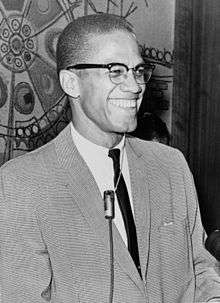 Malcolm X in March 1964 | |
| Born | Malcolm Little May 19, 1925 Omaha, Nebraska, U.S. |
| Died | February 21, 1965 (aged 39) New York City, U.S. |
| Cause of death | Gunshot wound |
| Resting place | Ferncliff Cemetery |
| Other names | el-Hajj Malik el-Shabazz |
| Occupation | Minister, activist |
| Organization |
|
| Movement |
|
| Spouse(s) | |
| Children | 6 (including Attallah, Qubilah, and Ilyasah) |
| Relatives | Louise Helen Norton Little (mother) Malcolm Shabazz (grandson)[1] |
| Signature | |
 | |
Born in Omaha, Nebraska, Malcolm X spent his teenage years living in a series of foster homes after his father's death and his mother's hospitalization. He engaged in several illicit activities there, eventually being sentenced to 10 years in prison in 1946 for larceny and breaking and entering. In prison, he joined the Nation of Islam, adopted the name Malcolm X, and quickly became one of the organization's most influential leaders after being paroled in 1952. Malcolm X then served as the public face of the organization for a dozen years, where he advocated for black supremacy, black empowerment, and the separation of black and white Americans, and publicly criticized the mainstream civil rights movement for its emphasis on nonviolence and racial integration. Malcolm X also expressed pride in some of the Nation's social welfare achievements, namely its free drug rehabilitation program. Throughout his life beginning in the 1950s, Malcolm X endured surveillance from the Federal Bureau of Investigation (FBI) for the Nation's supposed links to communism.
In the 1960s, Malcolm X began to grow disillusioned with the Nation of Islam, as well as with its leader Elijah Muhammad. He subsequently embraced Sunni Islam and the civil rights movement after completing the Hajj to Mecca, and became known as el-Hajj Malik el-Shabazz.[upper-alpha 1] After a brief period of travel across Africa, he publicly renounced the Nation of Islam and founded the Islamic Muslim Mosque, Inc. (MMI) and the Pan-African Organization of Afro-American Unity (OAAU). Throughout 1964, his conflict with the Nation of Islam intensified, and he was repeatedly sent death threats. On February 21, 1965, he was assassinated. Three Nation members were charged with the murder and given indeterminate life sentences. Speculation about the assassination and whether it was conceived or aided by leading or additional members of the Nation, or with law enforcement agencies, have persisted for decades after the shooting.
A controversial figure accused of preaching racism and violence, Malcolm X is a widely celebrated figure within African-American and Muslim American communities for his pursuit of racial justice. He was posthumously honored with Malcolm X Day, where he is commemorated in various countries worldwide. Hundreds of streets and schools in the U.S. have been renamed in his honor, while the Audubon Ballroom, the site of his assassination, was partly redeveloped in 2005 to accommodate the Malcolm X and Dr. Betty Shabazz Memorial and Educational Center.
Early years
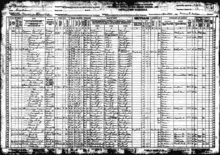
Malcolm Little was born May 19, 1925, in Omaha, Nebraska, the fourth of seven children of Grenada-born Louise Helen Little (née Norton) and Georgia-born Earl Little.[2] Earl was an outspoken Baptist lay speaker, and he and Louise were admirers of Pan-African activist Marcus Garvey. Earl was a local leader of the Universal Negro Improvement Association (UNIA) and Louise served as secretary and "branch reporter", sending news of local UNIA activities to Negro World; they inculcated self-reliance and black pride in their children.[3][4][5] Malcolm X later said that white violence killed four of his father's brothers.[6]
Because of Ku Klux Klan threats—Earl's UNIA activities were said to be "spreading trouble"[7]—the family relocated in 1926 to Milwaukee, Wisconsin, and shortly thereafter to Lansing, Michigan.[8] There the family was frequently harassed by the Black Legion, a white racist group Earl accused of burning their family home in 1929.[9]
When Malcolm was six, his father died in what has been officially ruled a streetcar accident, though his mother Louise believed Earl had been murdered by the Black Legion. Rumors that white racists were responsible for his father's death were widely circulated and were very disturbing to Malcolm X as a child. As an adult, he expressed conflicting beliefs on the question.[10] After a dispute with creditors, Louise received a life insurance benefit (nominally $1,000—about $17,000 in 2019 dollars[upper-alpha 2]) in payments of $18 per month;[11] the issuer of another, larger policy refused to pay, claiming her husband Earl had committed suicide.[12] To make ends meet Louise rented out part of her garden, and her sons hunted game.[13]
In 1937 a man Louise had been dating—marriage had seemed a possibility—vanished from her life when she became pregnant with his child.[14] In late 1938 she had a nervous breakdown and was committed to Kalamazoo State Hospital. The children were separated and sent to foster homes. Malcolm and his siblings secured her release 24 years later.[15][16]
Malcolm Little attended West Junior High School in Lansing and then Mason High School in Mason, Michigan, but left high school in 1941, before graduating.[17] He excelled in junior high school but dropped out of high school after a white teacher told him that practicing law, his aspiration at the time, was "no realistic goal for a nigger".[18] Later Malcolm X recalled feeling that the white world offered no place for a career-oriented black man, regardless of talent.[18]
From age 14 to 21, Malcolm held a variety of jobs while living with his half-sister Ella Little-Collins in Roxbury, a largely African-American neighborhood of Boston.[19][20]
After a short time in Flint, Michigan, he moved to New York City's Harlem neighborhood in 1943, where he engaged in drug dealing, gambling, racketeering, robbery, and pimping.[21] According to recent biographies, Malcolm also occasionally had sex with other men, usually for money, though this conjecture has been disputed by those who knew him.[22][23][upper-alpha 3] He befriended John Elroy Sanford, a fellow dishwasher at Jimmy's Chicken Shack in Harlem who aspired to be a professional comedian. Both men had reddish hair, so Sanford was called "Chicago Red" after his hometown and Malcolm was known as "Detroit Red". Years later, Sanford became famous as Redd Foxx.[31]
Summoned by the local draft board for military service in World War II, he feigned mental disturbance by rambling and declaring: "I want to be sent down South. Organize them nigger soldiers ... steal us some guns, and kill us [some] crackers".[32][33][34] He was declared "mentally disqualified for military service".[32][33][34]
In late 1945, Malcolm returned to Boston, where he and four accomplices committed a series of burglaries targeting wealthy white families.[35] In 1946, he was arrested while picking up a stolen watch he had left at a shop for repairs,[36] and in February began serving an eight-to-ten-year sentence at Charlestown State Prison for larceny and breaking and entering.[37]
Nation of Islam period
Prison
—Malcolm X[38]
When Malcolm was in prison, he met fellow convict John Bembry,[39] a self-educated man he would later describe as "the first man I had ever seen command total respect ... with words".[40] Under Bembry's influence, Little developed a voracious appetite for reading.[41]
At this time, several of his siblings wrote to him about the Nation of Islam, a relatively new religious movement preaching black self-reliance and, ultimately, the return of the African diaspora to Africa, where they would be free from white American and European domination.[42] He showed scant interest at first, but after his brother Reginald wrote in 1948, "Malcolm, don't eat any more pork and don't smoke any more cigarettes. I'll show you how to get out of prison",[43] he quit smoking and began to refuse pork.[44] After a visit in which Reginald described the group's teachings, including the belief that white people are devils, Malcolm concluded that every relationship he had had with whites had been tainted by dishonesty, injustice, greed, and hatred.[45] Malcolm, whose hostility to religion had earned him the prison nickname "Satan",[46] became receptive to the message of the Nation of Islam.[47]
In late 1948, Malcolm wrote to Elijah Muhammad, the leader of the Nation of Islam. Muhammad advised him to renounce his past, humbly bow in prayer to God, and promise never to engage in destructive behavior again.[48] Though he later recalled the inner struggle he had before bending his knees to pray,[49] Malcolm soon became a member of the Nation of Islam,[48] maintaining a regular correspondence with Muhammad.[50]
In 1950, the FBI opened a file on Malcolm after he wrote a letter from prison to President Truman expressing opposition to the Korean War and declaring himself a communist.[51] That year, he also began signing his name "Malcolm X".[52] Muhammad instructed his followers to leave their family names behind when they joined the Nation of Islam and use "X" instead. When the time was right, after they had proven their sincerity, he said, he would reveal the Muslim's "original name".[53] In his autobiography, Malcolm X explained that the "X" symbolized the true African family name that he could never know. "For me, my 'X' replaced the white slavemaster name of 'Little' which some blue-eyed devil named Little had imposed upon my paternal forebears."[54]
Early ministry
| Part of a series on: |
| Nation of Islam |
|---|
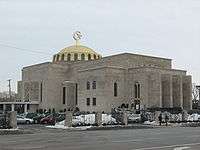 Mosque Maryam in Chicago |
|
Influencers
|
|
Leaders
|
|
Beliefs and theology
|
|
History
|
|
Publications
|
|
Subsidiaries
|
|
Offshoots and sects
|
|
Related organizations
|
|
|
After his parole in August 1952,[55] Malcolm X visited Elijah Muhammad in Chicago.[56] In June 1953 he was named assistant minister of the Nation's Temple Number One in Detroit.[57][upper-alpha 4] Later that year he established Boston's Temple Number 11;[59] in March 1954, he expanded Temple Number 12 in Philadelphia;[60] and two months later he was selected to lead Temple Number 7 in Harlem,[61] where he rapidly expanded its membership.[62]
In 1953, the FBI began surveillance of him, turning its attention from Malcolm X's possible communist associations to his rapid ascent in the Nation of Islam.[63]
During 1955, Malcolm X continued his successful recruitment of members on behalf of the Nation of Islam. He established temples in Springfield, Massachusetts (Number 13); Hartford, Connecticut (Number 14); and Atlanta, Georgia (Number 15). Hundreds of African Americans were joining the Nation of Islam every month.[64]
Besides his skill as a speaker, Malcolm X had an impressive physical presence. He stood 6 feet 3 inches (1.91 m) tall and weighed about 180 pounds (82 kg).[65] One writer described him as "powerfully built",[66] and another as "mesmerizingly handsome ... and always spotlessly well-groomed".[65]
Marriage and family
In 1955, Betty Sanders met Malcolm X after one of his lectures, then again at a dinner party; soon she was regularly attending his lectures. In 1956 she joined the Nation of Islam, changing her name to Betty X.[67] One-on-one dates were contrary to the Nation's teachings, so the couple courted at social events with dozens or hundreds of others, and Malcolm X made a point of inviting her on the frequent group visits he led to New York City's museums and libraries.[68]
Malcolm X proposed during a telephone call from Detroit in January 1958, and they married two days later.[69][70] They had six daughters: Attallah (b. 1958, named after Attila the Hun);[71][upper-alpha 5][upper-alpha 6] Qubilah (b. 1960, named after Kublai Khan);[75] Ilyasah (b. 1962, named after Elijah Muhammad);[76] Gamilah Lumumba (b. 1964, named after Gamal Abdel Nasser and Patrice Lumumba);[77][78] and twins Malikah and Malaak (b. 1965 after their father's death, and named in his honor).[79]
Hinton Johnson incident
The American public first became aware of Malcolm X in 1957, after Hinton Johnson,[upper-alpha 7] a Nation of Islam member, was beaten by two New York City police officers.[82][83] On April 26, Johnson and two other passersby—also Nation of Islam members—saw the officers beating an African-American man with nightsticks.[82] When they attempted to intervene, shouting, "You're not in Alabama ... this is New York!"[83] one of the officers turned on Johnson, beating him so severely that he suffered brain contusions and subdural hemorrhaging. All four African-American men were arrested.[82] Alerted by a witness, Malcolm X and a small group of Muslims went to the police station and demanded to see Johnson.[82] Police initially denied that any Muslims were being held, but when the crowd grew to about five hundred, they allowed Malcolm X to speak with Johnson.[84] Afterward, Malcolm X insisted on arranging for an ambulance to take Johnson to Harlem Hospital.[85]
Johnson's injuries were treated and by the time he was returned to the police station, some four thousand people had gathered outside.[84] Inside the station, Malcolm X and an attorney were making bail arrangements for two of the Muslims. Johnson was not bailed, and police said he could not go back to the hospital until his arraignment the following day.[85] Considering the situation to be at an impasse, Malcolm X stepped outside the station house and gave a hand signal to the crowd. Nation members silently left, after which the rest of the crowd also dispersed.[85] One police officer told the New York Amsterdam News: "No one man should have that much power."[85][86] Within a month the New York City Police Department arranged to keep Malcolm X under surveillance; it also made inquiries with authorities in other cities in which he had lived, and prisons in which he had served time.[87] A grand jury declined to indict the officers who beat Johnson. In October, Malcolm X sent an angry telegram to the police commissioner. Soon the police department assigned undercover officers to infiltrate the Nation of Islam.[88]
Increasing prominence
By the late 1950s, Malcolm X was using a new name, Malcolm Shabazz or Malik el-Shabazz, although he was still widely referred to as Malcolm X.[89] His comments on issues and events were being widely reported in print, on radio, and on television,[90] and he was featured in a 1959 New York City television broadcast about the Nation of Islam, The Hate That Hate Produced.[90]
In September 1960, at the United Nations General Assembly in New York City, Malcolm X was invited to the official functions of several African nations. He met Gamal Abdel Nasser of Egypt, Ahmed Sékou Touré of Guinea, and Kenneth Kaunda of the Zambian African National Congress.[91] Fidel Castro also attended the Assembly, and Malcolm X met publicly with him as part of a welcoming committee of Harlem community leaders.[92] Castro was sufficiently impressed with Malcolm X to suggest a private meeting, and after two hours of talking, Castro invited Malcolm X to visit Cuba.[93]
Advocacy and teachings while with Nation
From his adoption of the Nation of Islam in 1952 until he broke with it in 1964, Malcolm X promoted the Nation's teachings. These included beliefs:
- that black people are the original people of the world[94]
- that white people are "devils"[95]
- that blacks are superior to whites, and
- that the demise of the white race is imminent.[96]
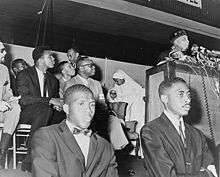
Many whites and some blacks were alarmed by Malcolm X and the statements he made during this period. He and the Nation of Islam were described as hatemongers, black supremacists, racists, violence-seekers, segregationists, and a threat to improved race relations. He was accused of being antisemitic.[97] In 1961, Malcolm X spoke at a NOI rally alongside George Lincoln Rockwell, the head of the American Nazi Party; Rockwell claimed that there was overlap between black nationalism and white supremacy.[98] One of the goals of the civil rights movement was to end disenfranchisement of African Americans, but the Nation of Islam forbade its members from participating in voting and other aspects of the political process.[99] The NAACP and other civil rights organizations denounced him and the Nation of Islam as irresponsible extremists whose views did not represent the common interests of African Americans.[100][101][102]
Malcolm X was equally critical of the civil rights movement.[103] He called Martin Luther King Jr. a "chump", and said other civil rights leaders were "stooges" of the white establishment.[104][upper-alpha 8] He called the 1963 March on Washington "the farce on Washington",[106] and said he did not know why so many black people were excited about a demonstration "run by whites in front of a statue of a president who has been dead for a hundred years and who didn't like us when he was alive".[107]
While the civil rights movement fought against racial segregation, Malcolm X advocated the complete separation of African Americans from whites. He proposed that African Americans should return to Africa and that, in the interim, a separate country for black people in America should be created.[108][109] He rejected the civil rights movement's strategy of nonviolence, arguing that black people should defend and advance themselves "by any means necessary".[110] His speeches had a powerful effect on his audiences, who were generally African Americans in northern and western cities. Many of them—tired of being told to wait for freedom, justice, equality and respect[111]—felt that he articulated their complaints better than did the civil rights movement.[112][113]
Effect on Nation membership
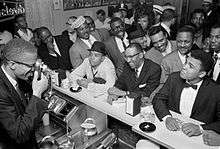
Malcolm X is widely regarded as the second most influential leader of the Nation of Islam after Elijah Muhammad.[114] He was largely credited with the group's dramatic increase in membership between the early 1950s and early 1960s (from 500 to 25,000 by one estimate;[upper-alpha 9] from 1,200 to 50,000 or 75,000 by another).[116][upper-alpha 10]
He inspired the boxer Cassius Clay to join the Nation,[118] and the two became close.[119] In January 1964, Clay brought Malcolm X and his family to Miami to watch him train for his fight against Sonny Liston.[120] When Malcolm X left the Nation of Islam, he tried to convince Clay (who had just been renamed Muhammad Ali by Elijah Muhammad) to join him in converting to Sunni Islam, but Clay instead broke ties with him—which he later described as one of his greatest regrets.[upper-alpha 11]
Malcolm X mentored and guided Louis X (later known as Louis Farrakhan), who eventually became the leader of the Nation of Islam.[122] Malcolm X also served as a mentor and confidant to Elijah Muhammad's son, Wallace D. Muhammad; the son told Malcolm X about his skepticism toward his father's "unorthodox approach" to Islam.[123] Wallace Muhammad was excommunicated from the Nation of Islam several times, although he was eventually readmitted.[124]
Disillusionment and departure
During 1962 and 1963, events caused Malcolm X to reassess his relationship with the Nation of Islam, and particularly its leader, Elijah Muhammad.
Lack of Nation of Islam response to LAPD violence
In late 1961, there were violent confrontations between the Nation of Islam members and police in South Central Los Angeles, and numerous Muslims were arrested. They were acquitted, but tensions had been raised. Just after midnight on April 27, 1962, two LAPD officers, unprovoked, shoved and beat several Muslims outside Temple Number 27. A large crowd of angry Muslims emerged from the mosque and the officers attempted to intimidate them. One officer was disarmed; his partner was shot in the elbow by a third officer. More than 70 backup officers arrived who then raided the mosque and randomly beat Nation of Islam members. Police officers shot seven Muslims, including William X Rogers, who was hit in the back and paralyzed for life, and Ronald Stokes, a Korean War veteran, who was shot from behind while raising his hands over his head to surrender, killing him.[125][126]
A number of Muslims were indicted after the event, but no charges were laid against the police. The coroner ruled that Stokes's killing was justified. To Malcolm X, the desecration of the mosque and the associated violence demanded action, and he used what Louis X (later Louis Farrakhan) later called his "gangsterlike past" to rally the more hardened of the Nation of Islam members to take violent revenge against the police. Malcolm X sought Elijah Muhammad's approval which was denied, stunning Malcolm X. Malcolm X was again blocked by Elijah Muhammad when he spoke of the Nation of Islam starting to work with civil rights organizations, local black politicians, and religious groups. Louis X saw this as an important turning point in the deteriorating relationship between Malcolm X and Muhammad.[125][126]
Sexual misbehavior by Elijah Muhammad
Rumors were circulating that Muhammad was conducting extramarital affairs with young Nation secretaries—which would constitute a serious violation of Nation teachings. After first discounting the rumors, Malcolm X came to believe them after he spoke with Muhammad's son Wallace and with the women making the accusations. Muhammad confirmed the rumors in 1963, attempting to justify his behavior by referring to precedents set by Biblical prophets.[127]
Nation of Islam response to remarks on Kennedy assassination
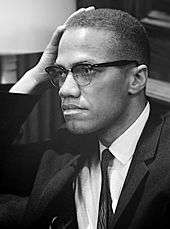
On December 1, 1963, when asked to comment on the assassination of John F. Kennedy, Malcolm X said that it was a case of "chickens coming home to roost". He added that "chickens coming home to roost never did make me sad; they've always made me glad."[128] The New York Times wrote, "in further criticism of Mr. Kennedy, the Muslim leader cited the murders of Patrice Lumumba, Congo leader, of Medgar Evers, civil rights leader, and of the Negro girls bombed earlier this year in a Birmingham church. These, he said, were instances of other 'chickens coming home to roost'."[128] The remarks prompted a widespread public outcry. The Nation of Islam, which had sent a message of condolence to the Kennedy family and ordered its ministers not to comment on the assassination, publicly censured their former shining star.[129] Malcolm X retained his post and rank as minister, but was prohibited from public speaking for 90 days.[130]
Media attention to Malcolm X over Muhammad
Malcolm X had by now become a media favorite, and some Nation members believed he was a threat to Muhammad's leadership. Publishers had shown interest in Malcolm X's autobiography, and when Louis Lomax wrote his 1963 book about the Nation, When the Word Is Given, he used a photograph of Malcolm X on the cover. He also reproduced five of his speeches, but featured only one of Muhammad's—all of which greatly upset Muhammad and made him envious.[131]
—Malcolm X[132]
Departure from Nation of Islam
On March 8, 1964, Malcolm X publicly announced his break from the Nation of Islam. He was still a Muslim, he said, but felt that the Nation had "gone as far as it can" because of its rigid teachings. He said he was planning to organize a black nationalist organization to "heighten the political consciousness" of African Americans. He also expressed a desire to work with other civil rights leaders, saying that Elijah Muhammad had prevented him from doing so in the past.[133]
Activity after leaving Nation of Islam
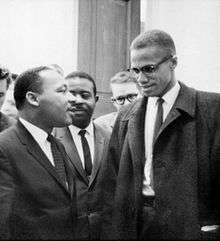
After leaving the Nation of Islam, Malcolm X founded Muslim Mosque, Inc. (MMI), a religious organization,[134][135] and the Organization of Afro-American Unity (OAAU), a secular group that advocated Pan-Africanism.[136][137] On March 26, 1964, he briefly met Martin Luther King Jr. for the first and only time—and only long enough for photographs to be taken—in Washington, D.C., as both men attended the Senate's debate on the Civil Rights bill at the US Capitol building.[upper-alpha 12][upper-alpha 13] In April, Malcolm X gave a speech titled "The Ballot or the Bullet", in which he advised African Americans to exercise their right to vote wisely but cautioned that if the government continued to prevent African Americans from attaining full equality, it might be necessary for them to take up arms.[140][141]
In the weeks after he left the Nation of Islam, several Sunni Muslims encouraged Malcolm X to learn about their faith. He soon converted to the Sunni faith.[142][143]
Pilgrimage to Mecca
In April 1964, with financial help from his half-sister Ella Little-Collins, Malcolm X flew to Jeddah, Saudi Arabia, as the start of his Hajj, the pilgrimage to Mecca obligatory for every Muslim who is able to do so. He was delayed in Jeddah when his U.S. citizenship and inability to speak Arabic caused his status as a Muslim to be questioned.[144][145] He had received Abdul Rahman Hassan Azzam's book The Eternal Message of Muhammad with his visa approval, and he contacted the author. Azzam's son arranged for his release and lent him his personal hotel suite. The next morning Malcolm X learned that Prince Faisal had designated him as a state guest.[146] Several days later, after completing the Hajj rituals, Malcolm X had an audience with the prince.[147]
Malcolm X later said that seeing Muslims of "all colors, from blue-eyed blonds to black-skinned Africans," interacting as equals led him to see Islam as a means by which racial problems could be overcome.[148]
Africa
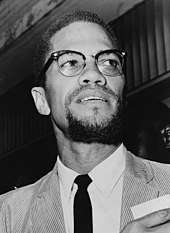
Malcolm X had already visited the United Arab Republic (a short-lived political union between Egypt and Syria), Sudan, Nigeria, and Ghana in 1959 to make arrangements for a tour of Africa by Elijah Muhammad.[149] After his journey to Mecca in 1964, he visited Africa a second time. He returned to the United States in late May[150] and flew to Africa again in July.[151] During these visits he met officials, gave interviews, and spoke on radio and television in Egypt, Ethiopia, Tanganyika, Nigeria, Ghana, Guinea, Sudan, Senegal, Liberia, Algeria, and Morocco.[152] In Cairo, he attended the second meeting of the Organization of African Unity as a representative of the OAAU.[153] By the end of this third visit, he had met with essentially all of Africa's prominent leaders;[154] Kwame Nkrumah of Ghana, Gamal Abdel Nasser of Egypt, and Ahmed Ben Bella of Algeria had all invited Malcolm X to serve in their governments.[154] After he spoke at the University of Ibadan, the Nigerian Muslim Students Association bestowed on him the honorary Yoruba name Omowale ("the son who has come home").[155] He later called this his most treasured honor.[156]
France and United Kingdom
On November 23, 1964, on his way home from Africa, Malcolm X stopped in Paris, where he spoke in the Salle de la Mutualité.[157][158] A week later, on November 30, Malcolm X flew to the United Kingdom, and on December 3 took part in a debate at the Oxford Union Society. The motion was taken from a statement made earlier that year by U.S. presidential candidate Barry Goldwater: "Extremism in the Defense of Liberty is No Vice; Moderation in the Pursuit of Justice is No Virtue".[159] Malcolm X argued for the affirmative, and interest in the debate was so high that it was televised nationally by the BBC.[160][161]
On February 5, 1965, Malcolm X flew to Britain again,[162] and on February 8 he addressed the first meeting of the Council of African Organizations in London.[163] The next day he tried to return to France, but was refused entry.[164]
On February 12, he visited Smethwick, near Birmingham, where the Conservative Party had won the parliamentary seat in the 1964 general election. The town had become a byword for racial division after Conservative supporters used the slogan, "If you want a nigger for a neighbor, vote Labour." In Smethwick he compared the treatment of ethnic minority residents with the treatment of Jews under Hitler, saying: "I would not wait for the fascist element in Smethwick to erect gas ovens."[165][166]
Return to United States
After returning to the U.S., Malcolm X addressed a wide variety of audiences. He spoke regularly at meetings held by MMI and the OAAU, and was one of the most sought-after speakers on college campuses.[167] One of his top aides later wrote that he "welcomed every opportunity to speak to college students".[168] He also addressed public meetings of the Socialist Workers Party, speaking at their Militant Labor Forum.[169] He was interviewed on the subjects of segregation and the Nation of Islam by Robert Penn Warren for Warren's 1965 book Who Speaks for the Negro?[170]
Death threats and intimidation from Nation of Islam
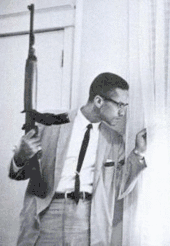
Throughout 1964, as his conflict with the Nation of Islam intensified, Malcolm X was repeatedly threatened.[171]
In February, a leader of Temple Number Seven ordered the bombing of Malcolm X's car.[172] In March, Muhammad told Boston minister Louis X (later known as Louis Farrakhan) that "hypocrites like Malcolm should have their heads cut off";[173] the April 10 edition of Muhammad Speaks featured a cartoon depicting Malcolm X's bouncing, severed head.[174][175]
On June 8, FBI surveillance recorded a telephone call in which Betty Shabazz was told that her husband was "as good as dead".[176] Four days later, an FBI informant received a tip that "Malcolm X is going to be bumped off."[177] (That same month the Nation sued to reclaim Malcolm X's residence in East Elmhurst, Queens, New York. His family was ordered to vacate[178] but on February 14, 1965—the night before a hearing on postponing the eviction—the house was destroyed by fire.)[179]
On July 9, Muhammad aide John Ali (suspected of being an undercover FBI agent)[180] referred to Malcolm X by saying, "Anyone who opposes the Honorable Elijah Muhammad puts their life in jeopardy."[181] In the December 4 issue of Muhammad Speaks, Louis X wrote that "such a man as Malcolm is worthy of death".[182]
The September 1964 issue of Ebony dramatized Malcolm X's defiance of these threats by publishing a photograph of him holding an M1 carbine while peering out a window.[183][184]
Assassination
On February 19, 1965, Malcolm X told interviewer Gordon Parks that the Nation of Islam was actively trying to kill him. On February 21, 1965, he was preparing to address the OAAU in Manhattan's Audubon Ballroom when someone in the 400-person audience yelled, "Nigger! Get your hand outta my pocket!"[186][187][188] As Malcolm X and his bodyguards tried to quell the disturbance,[upper-alpha 14] a man rushed forward and shot him once in the chest with a sawed-off shotgun[189][190] and two other men charged the stage firing semi-automatic handguns.[187] Malcolm X was pronounced dead at 3:30 pm, shortly after arriving at Columbia Presbyterian Hospital.[188] The autopsy identified 21 gunshot wounds to the chest, left shoulder, arms and legs, including ten buckshot wounds from the initial shotgun blast.[191]
One gunman, Nation of Islam member Talmadge Hayer (also known as Thomas Hagan), was beaten by the crowd before police arrived.[192][193] Witnesses identified the other gunmen as Nation members Norman 3X Butler and Thomas 15X Johnson.[194] All three were convicted of murder in March 1966 and sentenced to life in prison.[195][196] At trial Hayer confessed, but refused to identify the other assailants except to assert that they were not Butler and Johnson.[197] In 1977 and 1978, he signed affidavits reasserting Butler's and Johnson's innocence, naming four other Nation members of Newark’s Mosque No. 25 as participants in the murder or its planning.[198][199][200][201] These affidavits did not result in the case being reopened. In 2020, the Netflix docuseries Who Killed Malcolm X? explored the assassination, which launched a new review of the murder by the office of the Manhattan District Attorney.[202]
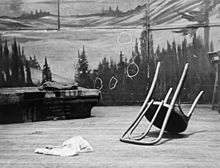
Butler, today known as Muhammad Abdul Aziz, was paroled in 1985 and became the head of the Nation's Harlem mosque in 1998; he maintains his innocence.[203] In prison Johnson, who changed his name to Khalil Islam, rejected the Nation's teachings and converted to Sunni Islam. Released in 1987, he maintained his innocence until his death in August 2009.[204][205] Hayer, who also rejected the Nation's teachings while in prison and converted to Sunni Islam,[206] is known today as Mujahid Halim.[207] He was paroled in 2010.[208]
A CNN Special Report, Witnessed: The Assassination of Malcolm X, was broadcast on February 17, 2015. It featured interviews with several people who worked with him, including A. Peter Bailey and Earl Grant, as well as the daughter of Malcolm X, Ilyasah Shabazz.[209][210][211]
Funeral
The public viewing, February 23–26 at Unity Funeral Home in Harlem, was attended by some 14,000 to 30,000 mourners.[212] For the funeral on February 27, loudspeakers were set up for the overflow crowd outside Harlem's thousand-seat Faith Temple of the Church of God in Christ,[213][214] and a local television station carried the service live.[215]
Among the civil rights leaders attending were John Lewis, Bayard Rustin, James Forman, James Farmer, Jesse Gray, and Andrew Young.[213][216] Actor and activist Ossie Davis delivered the eulogy, describing Malcolm X as "our shining black prince ... who didn't hesitate to die because he loved us so":
There are those who will consider it their duty, as friends of the Negro people, to tell us to revile him, to flee, even from the presence of his memory, to save ourselves by writing him out of the history of our turbulent times. Many will ask what Harlem finds to honor in this stormy, controversial and bold young captain—and we will smile. Many will say turn away—away from this man, for he is not a man but a demon, a monster, a subverter and an enemy of the black man—and we will smile. They will say that he is of hate—a fanatic, a racist—who can only bring evil to the cause for which you struggle! And we will answer and say to them: Did you ever talk to Brother Malcolm? Did you ever touch him, or have him smile at you? Did you ever really listen to him? Did he ever do a mean thing? Was he ever himself associated with violence or any public disturbance? For if you did you would know him. And if you knew him you would know why we must honor him ... And, in honoring him, we honor the best in ourselves.[217]
Malcolm X was buried at Ferncliff Cemetery in Hartsdale, New York.[215] Friends took up the gravediggers' shovels to complete the burial themselves.[218]
Actor and activist Ruby Dee and Juanita Poitier (wife of Sidney Poitier) established the Committee of Concerned Mothers to raise money for a home for his family and for his children's educations.[219]
Reactions
Reactions to Malcolm X's assassination were varied. In a telegram to Betty Shabazz, Martin Luther King Jr. expressed his sadness at "the shocking and tragic assassination of your husband".[220] He said,
While we did not always see eye to eye on methods to solve the race problem, I always had a deep affection for Malcolm and felt that he had a great ability to put his finger on the existence and root of the problem. He was an eloquent spokesman for his point of view and no one can honestly doubt that Malcolm had a great concern for the problems that we face as a race.[220]
Elijah Muhammad told the annual Savior's Day convention on February 26 that "Malcolm X got just what he preached", but denied any involvement with the murder.[221] "We didn't want to kill Malcolm and didn't try to kill him", Muhammad said, adding "We know such ignorant, foolish teachings would bring him to his own end."[222]
Writer James Baldwin, who had been a friend of Malcolm X's, was in London when he heard the news of the assassination. He responded with indignation towards the reporters interviewing him, shouting, "You did it! It is because of you—the men that created this white supremacy—that this man is dead. You are not guilty, but you did it ... Your mills, your cities, your rape of a continent started all this."[223]
The New York Post wrote that "even his sharpest critics recognized his brilliance—often wild, unpredictable and eccentric, but nevertheless possessing promise that must now remain unrealized".[224] The New York Times wrote that Malcolm X was "an extraordinary and twisted man" who "turn[ed] many true gifts to evil purpose" and that his life was "strangely and pitifully wasted".[225] Time called him "an unashamed demagogue" whose "creed was violence."[226]
Outside of the U.S., and particularly in Africa, the press was sympathetic.[227] The Daily Times of Nigeria wrote that Malcolm X would "have a place in the palace of martyrs".[228] The Ghanaian Times likened him to John Brown, Medgar Evers, and Patrice Lumumba, and counted him among "a host of Africans and Americans who were martyred in freedom's cause".[229][230] In China, the People's Daily described Malcolm X as a martyr killed by "ruling circles and racists" in the United States; his assassination, the paper wrote, demonstrated that "in dealing with imperialist oppressors, violence must be met with violence".[230] The Guangming Daily, also published in Beijing, stated that "Malcolm was murdered because he fought for freedom and equal rights".[231] in Cuba, El Mundo described the assassination as "another racist crime to eradicate by violence the struggle against discrimination".[227]
In a weekly column he wrote for the New York Amsterdam News, King reflected on Malcolm X and his assassination:
Malcolm X came to the fore as a public figure partially as a result of a TV documentary entitled, The Hate that Hate Produced. That title points to the nature of Malcolm's life and death.
Malcolm X was clearly a product of the hate and violence invested in the Negro's blighted existence in this nation. ...
In his youth, there was no hope, no preaching, teaching or movements of non-violence. ...
It is a testimony to Malcolm's personal depth and integrity that he could not become an underworld Czar, but turned again and again to religion for meaning and destiny. Malcolm was still turning and growing at the time of his brutal and meaningless assassination. ...
Like the murder of Lumumba, the murder of Malcolm X deprives the world of a potentially great leader. I could not agree with either of these men, but I could see in them a capacity for leadership which I could respect, and which was just beginning to mature in judgment and statesmanship.[232]
Allegations of conspiracy
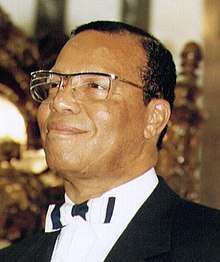
Within days, the question of who bore responsibility for the assassination was being publicly debated. On February 23, James Farmer, the leader of the Congress of Racial Equality, announced at a news conference that local drug dealers, and not the Nation of Islam, were to blame.[233] Others accused the NYPD, the FBI, or the CIA, citing the lack of police protection, the ease with which the assassins entered the Audubon Ballroom, and the failure of the police to preserve the crime scene.[234][235] Earl Grant, one of Malcolm X's associates who was present at the assassination, later wrote:
[A]bout five minutes later, a most incredible scene took place. Into the hall sauntered about a dozen policemen. They were strolling at about the pace one would expect of them if they were patrolling a quiet park. They did not seem to be at all excited or concerned about the circumstances.
I could hardly believe my eyes. Here were New York City policemen, entering a room from which at least a dozen shots had been heard, and yet not one of them had his gun out! As a matter of absolute fact, some of them even had their hands in their pockets.[236]
In the 1970s, the public learned about COINTELPRO and other secret FBI programs established to infiltrate and disrupt civil rights organizations during the 1950s and 1960s.[237] John Ali, national secretary of the Nation of Islam, was believed to have been an FBI undercover agent.[180] Malcolm X had confided to a reporter that Ali exacerbated tensions between him and Elijah Muhammad and that he considered Ali his "archenemy" within the Nation of Islam leadership.[180] Ali had a meeting with Talmadge Hayer, one of the men convicted of killing Malcolm X, the night before the assassination.[238]
The Shabazz family are among those who have accused Louis Farrakhan of involvement in Malcolm X's assassination.[239][240][241][242][243] In a 1993 speech Farrakhan seemed to acknowledge the possibility that the Nation of Islam was responsible:
Was Malcolm your traitor or ours? And if we dealt with him like a nation deals with a traitor, what the hell business is it of yours? A nation has to be able to deal with traitors and cutthroats and turncoats.[244][245]
In a 60 Minutes interview that aired during May 2000, Farrakhan stated that some things he said may have led to the assassination of Malcolm X. "I may have been complicit in words that I spoke", he said, adding "I acknowledge that and regret that any word that I have said caused the loss of life of a human being."[246] A few days later Farrakhan denied that he "ordered the assassination" of Malcolm X, although he again acknowledged that he "created the atmosphere that ultimately led to Malcolm X's assassination".[247]
No consensus has been reached on who was responsible for the assassination.[248] In August 2014, an online petition was started using the White House online petition mechanism to call on the government to release without alteration any files they still held relating to the murder of Malcolm X.[249] In January 2019, members of the families of Malcolm X, John F. Kennedy, Martin Luther King Jr., and Robert F. Kennedy were among dozens of Americans who signed a public statement calling for a truth and reconciliation commission to persuade Congress or the Justice Department to review the assassinations of all four leaders during the 1960s.[250][251]
Philosophy
Except for his autobiography, Malcolm X left no published writings. His philosophy is known almost entirely from the many speeches and interviews he gave from 1952 until his death.[252] Many of those speeches, especially from the last year of his life, were recorded and have been published.[253]
Beliefs of the Nation of Islam
—Malcolm X[254]
While he was a member of the Nation of Islam, Malcolm X taught its beliefs, and his statements often began with the phrase "The Honorable Elijah Muhammad teaches us that ..."[255] It is virtually impossible now to discern whether Malcolm X's personal beliefs at the time diverged from the teachings of the Nation of Islam.[256][upper-alpha 15] After he left the Nation in 1964, he compared himself to a ventriloquist's dummy who could only say what Elijah Muhammad told him to say.[255][upper-alpha 16]
Malcolm X taught that black people were the original people of the world,[94] and that whites were a race of devils who were created by an evil scientist named Yakub.[95] The Nation of Islam believed that black people were superior to white people and that the demise of the white race was imminent.[96] When questioned concerning his statements that white people were devils, Malcolm X said: "history proves the white man is a devil."[259] "Anybody who rapes, and plunders, and enslaves, and steals, and drops hell bombs on people ... anybody who does these things is nothing but a devil."[260]
Malcolm X said that Islam was the "true religion of black mankind" and that Christianity was "the white man's religion" that had been imposed upon African Americans by their slave-masters.[261] He said that the Nation of Islam followed Islam as it was practiced around the world, but the Nation's teachings varied from those of other Muslims because they were adapted to the "uniquely pitiful" condition of black people in the United States.[262] He taught that Wallace Fard Muhammad, the founder of the Nation, was God incarnate,[263] and that Elijah Muhammad was his Messenger, or Prophet.[upper-alpha 17]
While the civil rights movement fought against racial segregation, Malcolm X advocated the complete separation of blacks from whites. The Nation of Islam proposed the establishment of a separate country for African Americans in the southern[108] or southwestern United States[266] as an interim measure until African Americans could return to Africa.[109] Malcolm X suggested the United States government owed reparations to black people for the unpaid labor of their ancestors.[267] He also rejected the civil rights movement's strategy of nonviolence, advocating instead that black people should defend themselves.[110]
Independent views
—Malcolm X[268]
After leaving the Nation of Islam, Malcolm X announced his willingness to work with leaders of the civil rights movement,[133] though he advocated some changes to their policies. He felt that calling the movement a struggle for civil rights would keep the issue within the United States while changing the focus to human rights would make it an international concern. The movement could then bring its complaints before the United Nations, where Malcolm X said the emerging nations of the world would add their support.[269]
Malcolm X argued that if the U.S. government was unwilling or unable to protect black people, black people should protect themselves. He said that he and the other members of the OAAU were determined to defend themselves from aggressors, and to secure freedom, justice and equality "by whatever means necessary".[270]
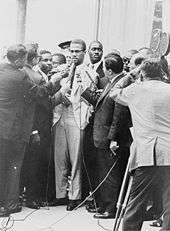
Malcolm X stressed the global perspective he gained from his international travels. He emphasized the "direct connection" between the domestic struggle of African Americans for equal rights with the independence struggles of Third World nations.[271] He said that African Americans were wrong when they thought of themselves as a minority; globally, black people were the majority.[272]
In his speeches at the Militant Labor Forum, which was sponsored by the Socialist Workers Party, Malcolm X criticized capitalism.[169] After one such speech, when he was asked what political and economic system he wanted, he said he did not know, but that it was no coincidence the newly independent countries in the Third World were turning toward socialism.[273] When a reporter asked him what he thought about socialism, Malcolm X asked whether it was good for black people. When the reporter told him it seemed to be, Malcolm X told him, "Then I'm for it."[273][274]
Although he no longer called for the separation of black people from white people, Malcolm X continued to advocate black nationalism, which he defined as self-determination for the African-American community.[275] In the last months of his life, however, Malcolm X began to reconsider his support for black nationalism after meeting northern African revolutionaries who, to all appearances, were white.[276]
After his Hajj, Malcolm X articulated a view of white people and racism that represented a deep change from the philosophy he had supported as a minister of the Nation of Islam. In a famous letter from Mecca, he wrote that his experiences with white people during his pilgrimage convinced him to "rearrange" his thinking about race and "toss aside some of [his] previous conclusions".[277] In a conversation with Gordon Parks, two days before his assassination, Malcolm said:
[L]istening to leaders like Nasser, Ben Bella, and Nkrumah awakened me to the dangers of racism. I realized racism isn't just a black and white problem. It's brought bloodbaths to about every nation on earth at one time or another.
Brother, remember the time that white college girls came into the restaurant—the one who wanted to help the [Black] Muslims and the whites get together—and I told her there wasn't a ghost of a chance and she went away crying? Well, I've lived to regret that incident. In many parts of the African continent, I saw white students helping black people. Something like this kills a lot of argument. I did many things as a [Black] Muslim that I'm sorry for now. I was a zombie then—like all [Black] Muslims—I was hypnotized, pointed in a certain direction and told to march. Well, I guess a man's entitled to make a fool of himself if he's ready to pay the cost. It cost me 12 years.
That was a bad scene, brother. The sickness and madness of those days—I'm glad to be free of them.[278]
Legacy
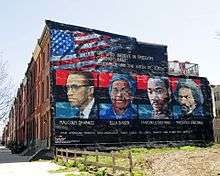
Malcolm X has been described as one of the greatest and most influential African Americans in history.[279][280][281] He is credited with raising the self-esteem of black Americans and reconnecting them with their African heritage.[282] He is largely responsible for the spread of Islam in the black community in the United States.[283][284][285] Many African Americans, especially those who lived in cities in the Northern and Western United States, felt that Malcolm X articulated their complaints concerning inequality better than did the mainstream civil rights movement.[112][113] One biographer says that by giving expression to their frustration, Malcolm X "made clear the price that white America would have to pay if it did not accede to black America's legitimate demands".[286]
In the late 1960s, increasingly radical black activists based their movements largely on Malcolm X and his teachings. The Black Power movement,[65][287] the Black Arts Movement,[65][288] and the widespread adoption of the slogan "Black is beautiful"[289] can all trace their roots to Malcolm X.
In 1963 Malcolm X began a collaboration with Alex Haley on his life story, The Autobiography of Malcolm X.[131] He told Haley, "If I'm alive when this book comes out, it will be a miracle."[290] Haley completed and published it some months after the assassination.[291]
During the late 1980s and early 1990s, there was a resurgence of interest in his life among young people. Hip-hop groups such as Public Enemy adopted Malcolm X as an icon,[292] and his image was displayed in hundreds of thousands of homes, offices, and schools,[293] as well as on T-shirts and jackets.[294] This wave peaked in 1992 with the release of the film Malcolm X,[295] an adaptation of The Autobiography of Malcolm X.
In 1998 Time named The Autobiography of Malcolm X one of the ten most influential nonfiction books of the 20th century.[296]
Malcolm X was an inspiration for several fictional characters. The Marvel Comics writer Chris Claremont confirmed that Malcolm X was an inspiration for the X-Men character Magneto, while Martin Luther King was an inspiration for Professor X.[297][298][299] Malcolm X also inspired the character Erik Killmonger in the film Black Panther.[300][301]
Memorials and tributes
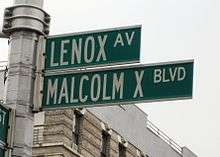
The house that once stood at 3448 Pinkney Street in North Omaha, Nebraska, was the first home of Malcolm Little with his birth family. The house was torn down in 1965 by new owners who did not know of its connection with Malcolm X.[302] The site was listed on the National Register of Historic Places in 1984.[303][304][305]
In Lansing, Michigan, a Michigan Historical Marker was erected in 1975 on Malcolm Little's childhood home.[306] The city is also home to El-Hajj Malik El-Shabazz Academy, a public charter school with an Afrocentric focus. The school is located in the building where Little attended elementary school.[307]
In cities around the world, Malcolm X's birthday (May 19) is commemorated as Malcolm X Day. The first known celebration of Malcolm X Day took place in Washington, D.C., in 1971.[308] The city of Berkeley, California, has recognized Malcolm X's birthday as a citywide holiday since 1979.[309]
Many cities have renamed streets after Malcolm X. In 1987, New York mayor Ed Koch proclaimed Lenox Avenue in Harlem to be Malcolm X Boulevard.[310] The name of Reid Avenue in Brooklyn, New York, was changed to Malcolm X Boulevard in 1985.[311][312] Brooklyn also has El Shabazz Playground that was named after him.[313] New Dudley Street, in the Roxbury neighborhood of Boston, was renamed Malcolm X Boulevard in the 1990s.[314] In 1997, Oakland Avenue in Dallas, Texas, was renamed Malcolm X Boulevard.[315] Main Street in Lansing, Michigan, was renamed Malcolm X Street in 2010.[316] In 2016, Ankara, Turkey, renamed the street on which the U.S. is building its new embassy after Malcolm X.[317][318][upper-alpha 18]
Dozens of schools have been named after Malcolm X, including Malcolm X Shabazz High School in Newark, New Jersey,[320] Malcolm Shabazz City High School in Madison, Wisconsin,[321] and Malcolm X College in Chicago, Illinois.[322] Malcolm X Liberation University, based on the Pan-Africanist ideas of Malcolm X, was founded in 1969 in North Carolina.[323]
In 1996, the first library named after Malcolm X was opened, the Malcolm X Branch Library and Performing Arts Center of the San Diego Public Library system.[324]
The U.S. Postal Service issued a Malcolm X postage stamp in 1999.[325] In 2005, Columbia University announced the opening of the Malcolm X and Dr. Betty Shabazz Memorial and Educational Center. The memorial is located in the Audubon Ballroom, where Malcolm X was assassinated.[326] Collections of Malcolm X's papers are held by the Schomburg Center for Research in Black Culture and the Robert W. Woodruff Library.[327][328][329]
Theatrical portrayal
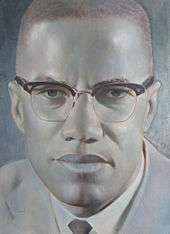
Denzel Washington played the title role in the 1992 motion picture Malcolm X[330]—named one of the ten best films of the 1990s by both critic Roger Ebert and director Martin Scorsese.[331] Washington had previously played the part of Malcolm X in the 1981 Off-Broadway play When the Chickens Came Home to Roost.[332] Other portrayals include:
- James Earl Jones, in the 1977 film The Greatest.[333]
- Dick Anthony Williams, in the 1978 television miniseries King[334] and the 1989 American Playhouse production of the Jeff Stetson play The Meeting.[335]
- Al Freeman Jr., in the 1979 television miniseries Roots: The Next Generations.[336]
- Morgan Freeman, in the 1981 television movie Death of a Prophet.[337]
- Ben Holt, in the 1986 opera X, The Life and Times of Malcolm X at the New York City Opera.[338]
- Gary Dourdan, in the 2000 television movie King of the World.[339]
- Joe Morton, in the 2000 television movie Ali: An American Hero.[340]
- Mario Van Peebles, in the 2001 film Ali.[341]
- Lindsay Owen Pierre, in the 2013 television movie Betty & Coretta.[342]
- Nigel Thatch, in the 2014 film Selma[343] and the 2019 television series Godfather of Harlem.[344]
Published works
- The Autobiography of Malcolm X. With the assistance of Alex Haley. New York: Grove Press, 1965. OCLC 219493184.
- Malcolm X Speaks: Selected Speeches and Statements. George Breitman, ed. New York: Merit Publishers, 1965. OCLC 256095445.
- Malcolm X Talks to Young People. New York: Young Socialist Alliance, 1965. OCLC 81990227.
- Two Speeches by Malcolm X. New York: Pathfinder Press, 1965. OCLC 19464959.
- Malcolm X on Afro-American History. New York: Merit Publishers, 1967. OCLC 78155009.
- The Speeches of Malcolm X at Harvard. Archie Epps, ed. New York: Morrow, 1968. OCLC 185901618.
- By Any Means Necessary: Speeches, Interviews, and a Letter by Malcolm X. George Breitman, ed. New York: Pathfinder Press, 1970. OCLC 249307.
- The End of White World Supremacy: Four Speeches by Malcolm X. Benjamin Karim, ed. New York: Monthly Review Press, 1971. OCLC 149849.
- The Last Speeches. Bruce Perry, ed. New York: Pathfinder Press, 1989. ISBN 978-0-87348-543-2.
- Malcolm X Talks to Young People: Speeches in the United States, Britain, and Africa. Steve Clark, ed. New York: Pathfinder Press, 1991. ISBN 978-0-87348-962-1.
- February 1965: The Final Speeches. Steve Clark, ed. New York: Pathfinder Press, 1992. ISBN 978-0-87348-749-8.
- The Diary of Malcolm X: 1964. Herb Boyd and Ilyasah Shabazz, eds. Chicago: Third World Press, 2013. ISBN 978-0-88378-351-1.
References
Notes
- Arabic: الحاجّ مالك الشباز; Arabic pronunciation: [al-ħad͡ʒː malik aʃːabaːz]. This name includes the honorific El-Hajj title, given on completion of the Hajj to Mecca. Malise Ruthven (1997). Islam: A Very Short Introduction. Oxford University Press. p. 147. ISBN 978-0-19-285389-9.
- Federal Reserve Bank of Minneapolis. "Consumer Price Index (estimate) 1800–". Retrieved January 1, 2020.
- The accuracy of these accounts has been questioned by some people who met Malcolm X later in life or never knew him, including Ta-Nehisi Coates,[24] Maulana Karenga,[25] Ilyasah Shabazz,[26] and Raymond Winbush.[27] For further information, see Phelps,[28] Polk,[29] and Street et al.[30]
- Nation of Islam Temples were numbered according to the order in which they were established.[58]
- Attallah Shabazz has said she was not named after Attila, rather her name is Arabic for "the gift of God".[72][73]
- "People have to understand the [Autobiography of Malcolm X] was written at a time when indeed African Americans were likening themselves to warriors to underscore our revolutionary fervor. And Attallah was close to Attila the Hun, the warrior. But I'm named Attallah, which in Arabic means 'Gift of God.' I've never been Attila."[74]
- Some sources, including The Autobiography of Malcolm X, give the name Johnson Hinton, but Benjamin Karim (one of Malcolm X's top aides) and former Newsweek editor and Malcolm X biographer Peter Goldman both give the name Hinton Johnson.[80][81]
- King expressed mixed feelings toward Malcolm X. "He is very articulate ... but I totally disagree with many of his political and philosophical views ... I don't want to seem to sound self-righteous ... or that I think I have the only truth, the only way. Maybe he does have some of the answer ... I have often wished that he would talk less of violence, because violence is not going to solve our problem. And in his litany of articulating the despair of the Negro without offering any positive, creative alternative, I feel that Malcolm has done himself and our people a great disservice ... [U]rging Negroes to arm themselves and prepare to engage in violence, as he has done, can reap nothing but grief."[105]
- "Estimates of the Black Muslim membership vary from a quarter of a million down to fifty thousand. Available evidence indicates that about one hundred thousand Negroes have joined the movement at one time or another, but few objective observers believe that the Black Muslims can muster more than twenty or twenty-five thousand active temple people."[115]
- "The common response of Malcolm X to questions about numbers—'Those who know aren't saying, and those who say don't know'—was typical of the attitude of the leadership."[117]
- "Turning my back on Malcolm was one of the mistakes that I regret most in my life. I wish I'd been able to tell Malcolm that I was sorry, that he was right about so many things. But he was killed before I got the chance ... I might never have become a Muslim if it hadn't been for Malcolm. If I could go back and do it over again, I would never have turned my back on him."[121]
- "There was no time for substantive discussions between the two. They were photographed greeting each other warmly, smiling and shaking hands."[138]
- "Camera shutters clicked. The next day, the Chicago Sun-Times, the New York World-Telegram and Sun, and other dailies carried a picture of Malcolm and Martin shaking hands."[139]
- In his Epilogue to The Autobiography of Malcolm X, Haley wrote that Malcolm X said, "Hold it! Hold it! Don't get excited. Let's cool it, brothers." (p. 499.) According to a transcript of an audio recording, Malcolm's only words were, "Hold it!", repeated ten times. (DeCaro, p. 274.)
- "'I'll be honest with you,' Malcolm X said to me. 'Everybody is talking about differences between the Messenger and me. It is absolutely impossible for us to differ.'"[257]
- On a radio program in December 1964, Malcolm X said "all of my former statements were prefaced by 'the Honorable Elijah Muhammad teaches thus and so.' They weren't my statements, they were his statements, and I was repeating them."[258]
- Malcolm X told Lewis Lomax that "The Messenger is the Prophet of Allah."[264] On another occasion, he said, "We never refer to the Honorable Elijah Muhammad as a prophet."[265]
- English-language sources disagreed whether the street was being renamed Malcolm X Road[317] or Malcolm X Avenue,[318] perhaps because of translation issues. The state media agency's English-language announcement said merely that "the street ... will bear the name of Malcolm X".[319]
Footnotes
- Harrison, Isheka N. (July 2010). "Malcolm X's Grandson Working on Memoirs in Miami". South Florida Times. Retrieved June 9, 2016.
- Watson, Clarence; Akhtar, Salman (2012). "Ideology and Identity: Malcolm X". In Akhtar, Salman (ed.). The African American Experience: Psychoanalytic Perspectives. Lanham, Md.: Jason Aronson. p. 120. ISBN 978-0-7657-0835-9.
- Marable, Malcolm X, pp. 20–30.
- Perry, pp. 2–3.
- Vincent, Ted (March–April 1989). "The Garveyite Parents of Malcolm X". The Black Scholar. 20 (2): 10–13. doi:10.1080/00064246.1989.11412923. JSTOR 41067613.
- Malcolm X, Autobiography, pp. 3–4.
- DeCaro, pp. 43–44.
- Natambu, p. 3.
- Natambu, p. 4.
- Marable, Malcolm X, p. 29.
- Marable, Malcolm X, p. 32
- Natambu, p. 10.
- Marable, Malcolm X, p. 32.
- Marable, Malcolm X, p. 35.
- Marable, Malcolm X, pp. 35–36, 265
- Perry, pp. 33–34, 331.
- Dozier, Vickki (February 21, 2015). "How Malcolm X's murder rippled through his hometown". Lansing State Journal. Lansing, MI.
- Perry, p. 42.
- Natambu, pp. 21–29, 55–56.
- Perry, pp. 32–48, 58–61.
- Perry, pp. 62–81.
- Marable, Malcolm X, pp. 65–66.
- Perry, pp. 77, 82–83.
- Coates, Ta-Nehisi (April 11, 2011). "The Sexuality of Malcolm X". The Atlantic. Retrieved September 7, 2017.
- Karenga, Maulana, "The Meaning and Measure of Malcolm X: Critical Remembrance and Rightful Reading", Boyd et al., By Any Means Necessary, p. 18.
- Martin, Michel (April 20, 2011). "Malcolm X's Daughter Disputes Claims in New Bio on Father". Tell Me More. NPR. Retrieved September 7, 2017.
- Winbush, Raymond A., "Speculative Nonfiction: Manning Marable's Malcolm X", Ball and Burroughs, A Lie of Reinvention, pp. 105–117.
- Phelps, Christopher (August 2017). "The Sexuality of Malcolm X" (PDF). Journal of American Studies. 51 (3): 659–690. doi:10.1017/S0021875816001341.
- Polk, Khary (Summer 2013). "Malcolm X, Sexual Hearsay, and Masculine Dissemblance". Biography. 36 (3): 568–584. doi:10.1353/bio.2013.0029. JSTOR 24570210.
- Street, Joe; Washington, Margaret; Hall, Simon; McLaughlin, Malcolm; Bailey, Peter (February 2013). "Roundtable – Manning Marable, Malcolm X: A Life of Reinvention". Journal of American Studies. 47 (1): 23–47. doi:10.1017/S0021875812002605.
- Marable, Malcolm X, pp. 51–52.
- Malcolm X, Autobiography, p. 124.
- Carson, p. 108.
- Lord, Lewis; Thornton, Jeannye; Bodipo-Memba, Alejandro (November 15, 1992). "The Legacy of Malcolm X". U.S. News & World Report. p. 5. Archived from the original on January 14, 2012. Retrieved March 20, 2018.
- Natambu, pp. 106–109.
- Perry, p. 99.
- Marable, Malcolm X, pp. 67–68.
- Malcolm X, Autobiography, p. 199.
- Natambu, p. 121.
- Malcolm X, Autobiography, p. 178; ellipsis in original.
- Perry, pp. 108–110, 118.
- Natambu, pp. 127–128, 132–138.
- Natambu, pp. 128–129.
- Perry, p. 113.
- Natambu, pp. 134–135.
- Perry, pp. 104–106.
- Natambu, p. 136.
- Natambu, pp. 138–139.
- Malcolm X, Autobiography, p. 196.
- Perry, p. 116.
- Marable, Malcolm X, p. 95.
- Marable, Malcolm X, p. 96.
- Natambu, pp. 139–140.
- Malcolm X, Autobiography, p. 229.
- Marable, Malcolm X, p. 98.
- Perry, pp. 142, 144–145.
- Natambu, p. 168.
- Perry, pp. 141–142.
- Perry, p. 147.
- Perry, p. 152.
- Perry, p. 153.
- Perry, pp. 161–164.
- Carson, p. 95.
- Marable, Malcolm X, pp. 122–123.
- Marable, "Rediscovering Malcolm's Life", p. 301.
- Lincoln, p. 189.
- Rickford, pp. 36–45, 50–51.
- Rickford, pp. 61–63.
- Shabazz, Betty, "Malcolm X as a Husband and Father", Clarke, pp. 132–134.
- Rickford, pp. 73–74.
- Rickford, pp. 109–110.
- Hopkins, Ellen (November 30, 1989). "Yolanda King and Attallah Shabazz: Their Fathers' Daughters". Rolling Stone. Retrieved June 19, 2016.
- Miller, Russell (November 23, 1992). "X Patriot". New York. Retrieved June 19, 2016.
- Barboza, pp. 205–206.
- Rickford, p. 122.
- Rickford, p. 123.
- Assensoh and Alex-Assensoh, p. xxi.
- Rickford, p. 197.
- Rickford, p. 286.
- Karim, pp. 47–48.
- Abdullah, Zain (Autumn 2012). "Narrating Muslim Masculinities: The Fruit of Islam and the Quest for Black Redemption". Spectrum: A Journal on Black Men. 1 (1): 169. doi:10.2979/spectrum.1.1.141.
- Marable, Malcolm X, p. 127.
- Perry, p. 164.
- Perry, p. 165.
- Marable, Malcolm X, p. 128.
- Perry, p. 166.
- Marable, Malcolm X, p. 132.
- Marable, Malcolm X, pp. 134–135.
- Marable, Malcolm X, pp. 135, 193.
- Perry, pp. 174–179.
- Natambu, pp. 231–233.
- Marable, Malcolm X, p. 172.
- Lincoln, p. 18.
- Lomax, When the Word Is Given, p. 55.
- Perry, p. 115.
- Lomax, When the Word Is Given, p. 57.
- Lomax, When the Word Is Given, p. 172.
- Heer, Jeet (May 11, 2016). "Farrakhan's Grand Illusion". The New Republic. Retrieved June 26, 2019.
- Natambu, p. 260.
- Marable, Malcolm X, p. 162.
- Natambu, pp. 215–216.
- "The Black Supremacists". Time. August 10, 1959. Retrieved October 2, 2014.
- Lomax, When the Word Is Given, pp. 79–80.
- Perry, p. 203.
- Haley, Alex (January 1965). "The Playboy Interview: Martin Luther King". Playboy. Retrieved June 19, 2018.
- Cone, p. 113.
- "Timeline". Malcolm X: Make It Plain, American Experience. PBS. May 19, 2005. Archived from the original on May 26, 2005. Retrieved November 11, 2017.
- Lomax, When the Word Is Given, pp. 149–152.
- Malcolm X, End of White World Supremacy, p. 78.
- Lomax, When the Word Is Given, pp. 173–174.
- Natambu, p. 182.
- Cone, pp. 99–100.
- West, Cornel (1984). "The Paradox of the Afro-American Rebellion". In Sayres, Sohnya; Stephanson, Anders; Aronowitz, Stanley; Jameson, Fredric (eds.). The 60s Without Apology. Minneapolis: University of Minnesota Press. p. 51. ISBN 978-0-8166-1336-6.
- Cone, p. 91.
- Lomax, When the Word Is Given, pp. 15–16.
- Marable, Malcolm X, p. 123.
- Clegg, p. 115.
- Natambu, pp. 296–297.
- Remnick, David (1999) [1998]. King of the World: Muhammed Ali and the Rise of an American Hero. New York: Vintage Books. p. 165. ISBN 978-0-375-70229-7.
- Rickford, p. 165.
- Ali, p. 85.
- Manning, Malcolm X.
- Marsh, p. 101.
- Marsh, pp. 58–59, 67.
- Branch, pp. 3–20.
- Marable, Malcolm X, pp. 205–210.
- Perry, pp. 230–234.
- "Malcolm X Scores U.S. and Kennedy". The New York Times. December 2, 1963. p. 21. Retrieved June 19, 2018.
- Natambu, pp. 288–290.
- Perry, p. 242.
- Perry, p. 214.
- X, Malcolm. "Media influence on society".
- Handler, M. S. (March 9, 1964). "Malcolm X Splits with Muhammad". The New York Times. p. 1. Retrieved June 19, 2018.
- Perry, pp. 251–252.
- Malcolm X, Malcolm X Speaks, pp. 18–22.
- Perry, pp. 294–296.
- Malcolm X, By Any Means Necessary, pp. 33–67.
- Cone, p. 2.
- Perry, p. 255.
- Perry, pp. 257–259.
- Malcolm X, Malcolm X Speaks, pp. 23–44.
- Marable, Malcolm X, pp. 300–301.
- Perry, p. 261.
- Perry, pp. 262–263.
- DeCaro, p. 204.
- Perry, pp. 263–265.
- Perry, p. 267.
- Malcolm X, Autobiography, pp. 388–393; quote from pp. 390–391.
- Lomax, When the Word Is Given, p. 62.
- Natambu, p. 303.
- Carson, p. 305.
- Natambu, pp. 304–305.
- Marable, Malcolm X, pp. 360–362.
- Natambu, p. 308.
- Perry, p. 269.
- Malcolm X, Autobiography, p. 403.
- Bethune, Lebert, "Malcolm X in Europe", Clarke, pp. 226–231.
- Malcolm X, By Any Means Necessary, pp. 113–126.
- Perlstein, Rick (August 2008). "1964 Republican Convention: Revolution from the Right". Smithsonian Magazine. Retrieved June 20, 2015.
- Bethune, "Malcolm X in Europe", Clarke, pp. 231–233.
- Malcolm X (December 3, 1964). "Malcolm X Oxford Debate". Malcolm X: A Research Site. Retrieved October 2, 2014.
- Carson, p. 349.
- Perry, p. 351.
- Natambu, p. 312.
- Kundnani, Arun (February 10, 2005). "Black British History: Remembering Malcolm's Visit to Smethwick". Independent Race and Refugee News Network. Institute of Race Relations. Retrieved October 2, 2014.
- Jeffries, Stuart (October 15, 2014). "Britain's Most Racist Election: The Story of Smethwick, 50 Years On". The Guardian. Retrieved April 17, 2016.
- Terrill, p. 9.
- Karim, p. 128.
- Perry, pp. 277–278.
- Robert Penn Warren Center for the Humanities. "Malcolm X". Who Speaks for the Negro?. Retrieved March 11, 2015.
- "The Malcolm X Project at Columbia University". www.columbia.edu. Retrieved December 13, 2019.
- Karim, pp. 159–160.
- Kondo, p. 170.
- Friedly, p. 169.
- Majied, Eugene (April 10, 1964). "On My Own". Muhammad Speaks. Nation of Islam. Retrieved October 2, 2014.
- Carson, p. 473.
- Carson, p. 324.
- Perry, pp. 290–292.
- Perry, pp. 352–356.
- Lomax, To Kill a Black Man, p. 198.
- Evanzz, p. 248.
- Evanzz, p. 264.
- Lord; Thornton; Bodipo-Memba (November 15, 1992). "The Legacy of Malcolm X". U.S. News & World Report. p. 3. Archived from the original on January 14, 2012. Retrieved March 20, 2018.
- Massaquoi, Hans J. (September 1964). "Mystery of Malcolm X". Ebony. pp. 38–40, 42, 44–46. Retrieved April 4, 2017.
- Ross, Janell (May 19, 2016). "Google Commemorates a Very Controversial Civil-Rights Figure, Yuri Kochiyama". The Washington Post. Retrieved May 20, 2016.
- Karim, p. 191.
- Evanzz, p. 295.
- Kihss, Peter (February 22, 1965). "Malcolm X Shot to Death at Rally Here". The New York Times. p. 1. Retrieved June 19, 2018.
- Marable, Malcolm X, pp. 436–437.
- Perry, p. 366.
- Marable, Malcolm X, p. 450.
- Perry, pp. 366–367.
- Talese, Gay (February 22, 1965). "Police Save Suspect From the Crowd". The New York Times. p. 10. Retrieved June 19, 2018.
- Kondo, p. 97.
- Buckley, Thomas (March 11, 1966). "Malcolm X Jury Finds 3 Guilty". The New York Times. p. 1. Retrieved June 19, 2018.
- Roth, Jack (April 15, 1966). "3 Get Life Terms in Malcolm Case". The New York Times. p. 36. Retrieved June 19, 2018.
- Kondo, p. 110.
- Leland, John (February 6, 2020). "Who Really Killed Malcolm X?". The New York Times. ISSN 0362-4331. Retrieved February 27, 2020.
- "Muslim Man Denies Author's Claim That He Killed Malcolm X". HuffPost. April 4, 2011. Retrieved February 27, 2020.
- Bush, Roderick (1999). We Are Not What We Seem: Black Nationalism and Class Struggle in the American Century. New York: New York University Press. p. 179. ISBN 978-0-8147-1317-4.
- Friedly, pp. 112–129.
- "Malcolm X assassination case may be reopened after Netflix documentary". NBC News. Retrieved February 27, 2020.
- "Malcolm X Killer Heads Mosque". BBC News. March 31, 1998. Retrieved October 2, 2014.
- Jacobson, Mark (October 1, 2007). "The Man Who Didn't Shoot Malcolm X". New York. Retrieved October 2, 2014.
- Marable, Malcolm X, p. 474.
- Fanelli, James (May 18, 2008). "Quiet Life of an 'X'-Assassin". The New York Post. Retrieved June 20, 2018.
- Rickford, p. 489.
- Marable, Malcolm X, pp. 474–475.
- "Witnessed: The Assassination of Malcolm X". CNN. February 2015. Retrieved June 13, 2015.
- Telusma, Blue (February 17, 2015). "Must Watch TV: 'Witnessed, The Assassination of Malcolm X'". The Grio. Retrieved June 13, 2015.
- Crockett Jr., Stephen A. (February 17, 2015). "CNN Hopes to Answer What Really Happened the Night Malcolm X Was Killed". The Root. Retrieved September 24, 2017.
- Perry, p. 374. Alex Haley, in his Epilogue to The Autobiography of Malcolm X, says 22,000 (p. 519).
- Rickford, p. 252.
- DeCaro, p. 291.
- Arnold, Martin (February 28, 1965). "Harlem Is Quiet as Crowds Watch Malcolm X Rites". The New York Times. p. 1. Retrieved June 19, 2018.
- DeCaro, p. 290.
- Davis, Ossie (February 27, 1965). "Malcolm X's Eulogy". The Official Website of Malcolm X. Retrieved August 9, 2016.
- Rickford, p. 255.
- Rickford, pp. 261–262.
- King Jr., Martin Luther (February 26, 1965). "Telegram from Martin Luther King Jr. to Betty al-Shabazz". The Martin Luther King Jr. Research and Education Institute. Archived from the original on February 1, 2016. Retrieved May 28, 2018.
- Evanzz, p. 301.
- Clegg, p. 232.
- DeCaro, p. 285.
- Rickford, p. 247.
- "Malcolm X". The New York Times. February 22, 1965. p. 20. Retrieved June 19, 2018.
- "Death and Transfiguration". Time. March 5, 1965. Retrieved October 2, 2014.
- Rickford, p. 248.
- Evanzz, p. 305.
- Kenworthy, E. W. (February 26, 1965). "Malcolm Called a Martyr Abroad". The New York Times. p. 15. Retrieved June 19, 2018.
- "How World Saw Malcolm X's Death" (PDF). New York Amsterdam News. March 13, 1965. Retrieved January 15, 2018.
- Evanzz, p. 306;
- King Jr., Martin Luther (March 13, 1965). "The Nightmare of Violence" (PDF). New York Amsterdam News. Retrieved January 15, 2018.
- Perry, p. 371.
- Marable, "Rediscovering Malcolm's Life", pp. 305–306.
- Perry, p. 372.
- Grant, Earl, "The Last Days of Malcolm X", Clarke, p. 96.
- Kondo, pp. 7–39.
- Evanzz, p. 294.
- Rickford, pp. 437, 492–495.
- Evanzz, pp. 298–299.
- Friedly, p. 253.
- Kondo, pp. 182–183, 193–194.
- Marable, "Rediscovering Malcolm's Life", p. 305.
- Rickford, p. 492.
- Wartofsky, Alona (February 17, 1995). "Brother Minister: The Martyrdom of Malcolm X". The Washington Post. Retrieved October 2, 2014.
- "Farrakhan Admission on Malcolm X". 60 Minutes. CBS News. May 14, 2000. Retrieved October 2, 2014.
- "Farrakhan Responds to Media Attacks". The Final Call. May 15, 2000. Retrieved October 2, 2014.
- Natambu, pp. 315–316.
- "Release Government Files on Malcolm X Assassination". The Boston Globe. January 10, 2015. Retrieved November 11, 2017.
- Jackman, Tom (January 25, 2019). "Kennedy, King, Malcolm X relatives and scholars seek new assassination probes". The Washington Post. Retrieved January 26, 2019.
- Simkin, John (January 2019). "Kennedy and King Family Members and Advisors Call for Congress to Reopen Assassination Probes". Spartacus Educational. Retrieved January 26, 2019.
- Kelley, Robin D. G. (1999). "Malcolm X". Africana: The Encyclopedia of the African and African American Experience. New York: Basic Civitas Books. p. 1233.
- Terrill, pp. 15–16.
- X, Malcolm. "God's Judgement of White America". www.malcolm-x.org. Archived from the original on April 8, 2016. Retrieved April 2, 2016.
- Lomax, When the Word Is Given, pp. 80–81.
- Terrill, p. 184.
- Lomax, When the Word Is Given, p. 91.
- Malcolm X, Last Speeches, p. 104.
- Lomax, When the Word Is Given, p. 67.
- Lomax, When the Word Is Given, p. 171.
- Lomax, When the Word Is Given, pp. 24, 137–138.
- Malcolm X, Speeches at Harvard, p. 119.
- DeCaro, pp. 166–167.
- Lomax, When the Word Is Given, p. 80.
- Malcolm X, Last Speeches, p. 46.
- Lincoln, p. 95.
- Lincoln, p. 96.
- Malcolm X, "The Negro's Fight", The Egyptian Gazette, August 25, 1964. Reprinted as "Racism: The Canver That Is Destroying America" in Clarke, pp. 302–306.
- Malcolm X, Malcolm X Speaks, pp. 33–35.
- Malcolm X, By Any Means Necessary, pp. 43, 47.
- Malcolm X, Malcolm X Speaks, p. 90.
- Malcolm X, Malcolm X Speaks, p. 117.
- Cone, p. 284.
- Perry, p. 277.
- Malcolm X, Malcolm X Speaks, pp. 38–41.
- Malcolm X, Malcolm X Speaks, pp. 212–213.
- Malcolm X, Autobiography, p. 391.
- Parks, Gordon, "Malcolm X: The Minutes of Our Last Meeting", Clarke, p. 122.
- Asante, Molefi Kete (2002). 100 Greatest African Americans: A Biographical Encyclopedia. Amherst, N.Y.: Prometheus Books. p. 333. ISBN 978-1-57392-963-9.
- Marable, Manning; Frazier, Nishani; McMillian, John Campbell (2003). Freedom on My Mind: The Columbia Documentary History of the African American Experience. New York: Columbia University Press. p. 251. ISBN 978-0-231-10890-4.
- Salley, Columbus (1999). The Black 100: A Ranking of the Most Influential African-Americans, Past and Present. New York: Citadel Press. p. 88. ISBN 978-0-8065-2048-3.
- Cone, pp. 291–292.
- Nasr, Seyyed Hossein (2002). The Heart of Islam: Enduring Values for Humanity. New York: HarperCollins. p. 97. ISBN 978-0-06-073064-2.
- Perry, p. 379.
- Turner, Richard Brent (2004). "Islam in the African-American Experience". In Bobo, Jacqueline; Hudley, Cynthia; Michel, Claudine (eds.). The Black Studies Reader. New York: Routledge. p. 445. ISBN 978-0-415-94554-7.
- Perry, p. 380.
- Sales, p. 187.
- Woodard, Komozi (1999). A Nation Within a Nation: Amiri Baraka (LeRoi Jones) & Black Power Politics. Chapel Hill, N.C.: University of North Carolina Press. p. 62. ISBN 978-0-8078-4761-9.
- Cone, p. 291.
- Haley, "Epilogue", Autobiography, p. 471.
- Perry, p. 375.
- Sales, p. 5.
- Marable, "Rediscovering Malcolm's Life", pp. 301–302.
- Sales, p. 3.
- Sales, p. 4.
- Gray, Paul (June 8, 1998). "Required Reading: Nonfiction Books". Time. Retrieved March 28, 2016.
- Young, Paul. "Real Life Inspirations Behind Some of the Best Comic Book Villains".
- Hanks, Henry. "The secret to 'X-Men's' success".
- Darowski, Joseph J. The Ages of the X-Men:Essays on the Children of the Atom in Changing Times. p. 71.
- Eells, Josh (February 18, 2018). "The 'Black Panther' Revolution". Rolling Stone. Archived from the original on February 25, 2018. Retrieved March 2, 2018.
- Ramos, Dino-Ray; N'Duka, Amanda (January 9, 2019). "New Hollywood Podcast: Michael B. Jordan Talks How 'Black Panther' Shifted Hollywood's Idea Of Representation". Deadline Hollywood. Retrieved October 2, 2019.
- McMorris, Robert (March 11, 1989). "Empty Lot Holds Dreams for Rowena Moore". Omaha World-Herald. Retrieved October 2, 2014.
- "National Register of Historic Places – Nebraska, Douglas County". National Register of Historic Places. Retrieved October 2, 2014.
- "NRHP: Malcolm X House Site". Nebraska State Historical Society. Retrieved June 20, 2018.
- "Nebraska Historical Marker: Malcolm X". Nebraska State Historical Society. Retrieved June 20, 2018.
- "Malcolm X Homesite". Michigan Historical Markers. Retrieved June 20, 2018.
- Yancey, Patty (2000). "We Hold on to Our Kids, We Hold on Tight: Tandem Charters in Michigan". In Fuller, Bruce (ed.). Inside Charter Schools: The Paradox of Radical Decentralization. Cambridge, Mass.: Harvard University Press. p. 67. ISBN 978-0-674-00325-5.
- Gay, Kathlyn (2007). African-American Holidays, Festivals and Celebrations. Detroit: Omnigraphics. p. 284. ISBN 978-0-7808-0779-2.
- Thaai, Walker (May 20, 2005). "Berkeley Honors Controversial Civil Rights Figure". San Jose Mercury News.
- Rickford, p. 443.
- Rickford, p. 419.
- Barron, James (January 18, 2009). "'Not Much of a Block,' but It's Named for a King". The New York Times. Retrieved June 19, 2018.
- "El Shabazz Playground : NYC Parks". New York City Department of Parks and Recreation. Retrieved February 21, 2020.
- DeCosta-Klipa, Nik (September 19, 2019). "Boston residents will get to vote on changing the name of Dudley Square. Here's why". Boston.com. Retrieved October 4, 2019.
- Scoville, Jen (December 1997). "The Big Beat". Texas Monthly. Archived from the original on December 29, 2004. Retrieved October 2, 2014.
- Vela, Susan (September 14, 2010). "Malcolm X, Cesar Chavez Get Nods for Lansing Street, Plaza Names". Lansing State Journal.
- Harvey, Benjamin (October 14, 2018). "Turkey Names Street Leading to U.S. Embassy 'Malcolm X Road'". Bloomberg News. Retrieved October 23, 2018.
- Kent, Lauren (October 15, 2018). "Turkey renames street of new US Embassy to Malcolm X Avenue". CNN. Retrieved October 23, 2018.
- Calik, Burcu (October 13, 2018). "Turkey: New US Embassy street to be named 'Malcolm X'". Anadolu Agency. Retrieved October 23, 2018.
- Lee, Felicia R. (May 15, 1993). "Newark Students, Both Good and Bad, Make Do". The New York Times. Retrieved June 19, 2018.
- Hunt, Lori Bona (February 26, 1991). "Malcolm X's Widow Sees Signs of Hope". Milwaukee Journal.
- Witkowsky, Kathy (Spring 2000). "A Day in the Life". National CrossTalk. Retrieved October 2, 2014.
- Belvin, Brent (October 6, 2004). "Master's Thesis: Malcolm X Liberation University: An Experiment in Independent Black Education". North Carolina State University. Retrieved October 2, 2014.
- Flynn, Pat (January 7, 1996). "Big Crowd Welcomes New Library Warmly". The San Diego Union-Tribune.
- Marable, "Rediscovering Malcolm's Life", pp. 303–304.
- "Malcolm X and Dr. Betty Shabazz Memorial and Educational Center Launches". Columbia University. May 17, 2005. Retrieved October 2, 2014.
- Marable, Malcolm X, p. 564.
- Hendrick, Bill (September 2, 1999). "A Revelation in Letters: Educated, Tender Malcolm X". The Atlanta Journal-Constitution. ProQuest 413815431.
- Eakin, Emily (January 8, 2003). "Malcolm X Trove to Schomburg Center". The New York Times. Retrieved June 19, 2018.
- Canby, Vincent (November 18, 1992). "'Malcolm X,' as Complex as Its Subject". The New York Times. Retrieved June 19, 2018.
- Anderson, Jeffrey M. "The Best Films of the 1990s". Combustible Celluloid. Archived from the original on January 24, 2001. Retrieved November 11, 2017.
- Rich, Frank (July 15, 1981). "The Stage: Malcolm X and Elijah Muhammad". The New York Times. Retrieved June 19, 2018.
- Canby, Vincent (May 21, 1977). "Ali's Latest Victory Is 'The Greatest'". The New York Times. Retrieved June 19, 2018.
- O'Connor, John J. (February 9, 1978). "TV: 6‐Hour 'King,' Drama of Civil Rights Drive". The New York Times. Retrieved June 19, 2018.
- Goodman, Walter (May 3, 1989). "An Imaginary Meeting of Dr. King and Malcolm X". The New York Times. Retrieved June 19, 2018.
- Maslin, Janet (February 25, 1979). "TV: End of 'Roots II' Delineates 60's". The New York Times. Retrieved June 19, 2018.
- "The Deification of Morgan Freeman: An Incomplete Filmography". The New York Times. August 28, 2011. Retrieved June 19, 2018.
- Henahan, Donal (September 29, 1986). "Opera: Anthony Davis's 'X (The Life and Times of Malcolm X)'". The New York Times. Retrieved June 19, 2018.
- Romano, Frederick V. (2004). The Boxing Filmography: American Features, 1920–2003. Jefferson, N.C.: McFarland & Company. pp. 138–139. ISBN 978-0-7864-1793-3.
- Gallo, Phil (August 30, 2000). "Review: 'Ali: An American Hero'". Variety. Retrieved June 9, 2016.
- Mitchell, Elvis (December 25, 2001). "Master of the Boast, King of the Ring, Vision of the Future". The New York Times. Retrieved June 19, 2018.
- Lowry, Brian (January 30, 2013). "Review: 'Betty & Coretta'". Variety. Retrieved June 9, 2016.
- Scott, A. O. (December 24, 2014). "A 50-Mile March, Nearly 50 Years Later". The New York Times. Retrieved June 19, 2018.
- Petski, Denise (September 21, 2018). "'Godfather Of Harlem': Nigél Thatch To Star As Malcolm X In Epix Drama Series". Deadline. Retrieved December 18, 2019.
Works cited
- Ali, Muhammad (2004). The Soul of a Butterfly: Reflections on Life's Journey. with Hana Yasmeen Ali. New York: Simon & Schuster. ISBN 978-0-7432-5569-1.
- Assensoh, A. B.; Alex-Assensoh, Yvette M. (2016). Malcolm X and Africa. Amherst, N.Y.: Cambria Press. ISBN 978-1-60497-924-4.
- Ball, Jared A.; Burroughs, Todd Steven, eds. (2012). A Lie of Reinvention: Correcting Manning Marable's Malcolm X. Baltimore: Black Classic Press. ISBN 978-1-57478-049-9.
- Barboza, Steven (1994). American Jihad: Islam After Malcolm X. New York: Image Books. ISBN 978-0-385-47694-2.
- Boyd, Herb; Daniels, Ron; Karenga, Maulana; Madhubuti, Haki R., eds. (2012). By Any Means Necessary: Malcolm X: Real, Not Reinvented. Chicago: Third World Press. ISBN 978-0-88378-336-8.\
- Branch, Taylor (1998). Pillar of Fire: America in the King Years, 1963–65. New York: Simon & Schuster. ISBN 978-0-684-80819-2.
- Carson, Clayborne (1991). Malcolm X: The FBI File. New York: Carroll & Graf. ISBN 978-0-88184-758-1.
- Clarke, John Henrik, ed. (1990) [1969]. Malcolm X: The Man and His Times. Trenton, N.J.: Africa World Press. ISBN 978-0-86543-201-7.
- Clegg III, Claude Andrew (1997). An Original Man: The Life and Times of Elijah Muhammad. New York: St. Martin's Griffin. ISBN 978-0-312-18153-6.
- Cone, James H. (1991). Martin & Malcolm & America: A Dream or a Nightmare. Maryknoll, N.Y.: Orbis Books. ISBN 978-0-88344-721-5.
- DeCaro Jr., Louis A. (1996). On the Side of My People: A Religious Life of Malcolm X. New York: New York University Press. ISBN 978-0-8147-1864-3.
- Dyson, Michael Eric (1995). Making Malcolm: The Myth and Meaning of Malcolm X. Oxford: Oxford University Press. ISBN 978-0-19-509235-6.
- Evanzz, Karl (1992). The Judas Factor: The Plot to Kill Malcolm X. New York: Thunder's Mouth Press. ISBN 978-1-56025-049-4.
- Friedly, Michael (1992). Malcolm X: The Assassination. New York: One World. ISBN 978-0-345-40010-9.
- Karim, Benjamin; with Peter Skutches and David Gallen (1992). Remembering Malcolm. New York: Carroll & Graf. ISBN 978-0-88184-881-6.
- Kondo, Zak A. (1993). Conspiracys: Unravelling the Assassination of Malcolm X. Washington, D.C.: Nubia Press. OCLC 28837295.
- Lincoln, C. Eric (1961). The Black Muslims in America. Boston: Beacon Press. OCLC 422580.
- Lomax, Louis E. (1987) [1968]. To Kill a Black Man: The Shocking Parallel in the Lives of Malcolm X and Martin Luther King Jr. Los Angeles: Holloway House. ISBN 978-0-87067-731-1.
- Lomax, Louis E. (1963). When the Word Is Given: A Report on Elijah Muhammad, Malcolm X, and the Black Muslim World. Cleveland: World Publishing. OCLC 1071204.
- Malcolm X; with the assistance of Alex Haley (1992) [1965]. The Autobiography of Malcolm X. New York: One World. ISBN 978-0-345-37671-8. Citations in this article refer to this edition, of the many that have been published.
- Malcolm X (1989) [1970]. By Any Means Necessary: Speeches, Interviews, and a Letter by Malcolm X. George Breitman, ed. New York: Pathfinder Press. ISBN 978-0-87348-150-2.
- Malcolm X (1989) [1971]. The End of White World Supremacy: Four Speeches by Malcolm X. Benjamin Karim, ed. New York: Arcade. ISBN 978-1-55970-006-1.
- Malcolm X (1989). The Last Speeches. Bruce Perry, ed. New York: Pathfinder Press. ISBN 978-0-87348-543-2.
- Malcolm X (1990) [1965]. Malcolm X Speaks: Selected Speeches and Statements. George Breitman, ed. New York: Grove Weidenfeld. ISBN 978-0-8021-3213-0.
- Malcolm X (1991) [1968]. The Speeches of Malcolm X at Harvard. Archie Epps, ed. New York: Paragon House. ISBN 978-1-55778-479-7.
- Marable, Manning (2011). Malcolm X: A Life of Reinvention. New York: Viking. ISBN 978-0-670-02220-5.
- Marable, Manning (2009). "Rediscovering Malcolm's Life: A Historian's Adventures in Living History". In Marable, Manning; Aidi, Hishaam D (eds.). Black Routes to Islam. New York: Palgrave Macmillan. ISBN 978-1-4039-8400-5.
- Marsh, Clifton E. (2000) [1996]. The Lost-Found Nation of Islam in America. Lanham, Md.: Scarecrow Press. ISBN 978-1-57886-008-1.
- Natambu, Kofi (2002). The Life and Work of Malcolm X. Indianapolis: Alpha Books. ISBN 978-0-02-864218-5.
- Perry, Bruce (1991). Malcolm: The Life of a Man Who Changed Black America. Barrytown, N.Y.: Station Hill. ISBN 978-0-88268-103-0.
- Rickford, Russell J. (2003). Betty Shabazz: A Remarkable Story of Survival and Faith Before and After Malcolm X. Naperville, Ill.: Sourcebooks. ISBN 978-1-4022-0171-4.
- Roberts, Randy; Smith, Johnny (2016). Blood Brothers: The Fatal Friendship Between Muhammad Ali and Malcolm X. New York: Basic Books. ISBN 978-0-465-07970-4.
- Sales Jr., William W. (1994). From Civil Rights to Black Liberation: Malcolm X and the Organization of Afro-American Unity. Boston: South End Press. ISBN 978-0-89608-480-3.
- Terrill, Robert (2004). Malcolm X: Inventing Radical Judgment. Lansing, Mich.: Michigan State University Press. ISBN 978-0-87013-730-3.
- Wood, Joe, ed. (1992). Malcolm X: In Our Image. New York: St. Martin's Press. ISBN 978-0-312-06609-3.
Further reading
- Abernethy, Graeme (2013). The Iconography of Malcolm X. Lawrence, Kan.: University Press of Kansas. ISBN 978-0-7006-1920-7.
- Baldwin, James (2007) [1973]. One Day, When I Was Lost: A Scenario Based on Alex Haley's "The Autobiography of Malcolm X". New York: Vintage. ISBN 978-0-307-27594-3.
- Bailey, A. Peter (2013). Witnessing Brother Malcolm X: The Master Teacher. Plantation, Fla.: Llumina Press. ISBN 978-1-62550-039-7.
- Breitman, George (1967). The Last Year of Malcolm X: The Evolution of a Revolutionary. New York: Pathfinder Press. ISBN 978-0-87348-004-8.
- Breitman, George; Porter, Herman; Smith, Baxter (1991) [1976]. The Assassination of Malcolm X. New York: Pathfinder Press. ISBN 978-0-87348-632-3.
- Cleage, Albert B.; Breitman, George (1968). Myths About Malcolm X: Two Views. New York: Merit. OCLC 615819.
- Collins, Rodnell P.; with A. Peter Bailey (1998). Seventh Child: A Family Memoir of Malcolm X. Secaucus, N.J.: Birch Lane Press. ISBN 978-1-55972-491-3.
- Conyers Jr., James L.; Smallwood, Andrew P., eds. (2008). Malcolm X: A Historical Reader. Durham, N.C.: Carolina Academic Press. ISBN 978-0-89089-228-2.
- DeCaro, Louis A. (1998). Malcolm and the Cross: The Nation of Islam, Malcolm X, and Christianity. New York: New York University Press. ISBN 978-0-8147-1932-9.
- Gallen, David, ed. (1992). Malcolm X: As They Knew Him. New York: Carroll & Graf. ISBN 978-0-88184-850-2.
- Goldman, Peter (1979). The Death and Life of Malcolm X (2nd ed.). Urbana, Ill.: University of Illinois Press. ISBN 978-0-252-00774-3.
- Jamal, Hakim A. (1972). From The Dead Level: Malcolm X and Me. New York: Random House. ISBN 978-0-394-46234-9.
- Jenkins, Robert L. (2002). The Malcolm X Encyclopedia. Westport, Conn.: Greenwood Press. ISBN 978-0-313-29264-4.
- Kly, Yussuf Naim, ed. (1986). The Black Book: The True Political Philosophy of Malcolm X (El Hajj Malik El Shabazz). Atlanta: Clarity Press. ISBN 978-0-932863-03-4.
- Leader, Edward Roland (1993). Understanding Malcolm X: The Controversial Changes in His Political Philosophy. New York: Vantage Press. ISBN 978-0-533-09520-9.
- Lee, Spike; with Ralph Wiley (1992). By Any Means Necessary: The Trials and Tribulations of the Making of Malcolm X. New York: Hyperion. ISBN 978-1-56282-913-1.
- Marable, Manning; Felber, Garrett, eds. (2013). The Portable Malcolm X Reader. New York: Penguin. ISBN 978-0-14-310694-4.
- Shabazz, Ilyasah; with Kim McLarin (2002). Growing Up X: A Memoir by the Daughter of Malcolm X. New York: One World. ISBN 978-0-345-44495-0.
- Sherwood, Marika (2011). Malcolm X Visits Abroad. Hollywood, Calif.: Tsehai Publishers. ISBN 978-1-59907-050-6.
- Strickland, William; et al. (1994). Malcolm X: Make It Plain. New York: Penguin Books. ISBN 978-0-14-017713-8.
- Terrill, Robert, ed. (2010). The Cambridge Companion to Malcolm X. Cambridge: Cambridge University Press. ISBN 978-0-521-73157-7.
- T'Shaka, Oba (1983). The Political Legacy of Malcolm X. Richmond, Calif.: Pan Afrikan Publications. ISBN 978-1-878557-01-8.
- Waldschmidt-Nelson, Britta (2012). Dreams and Nightmares: Martin Luther King Jr., Malcolm X, and the Struggle for Black Equality. Gainesville, Fla.: University Press of Florida. ISBN 978-0-8130-3723-3.
- Wolfenstein, Eugene Victor (1989). The Victims of Democracy: Malcolm X and the Black Revolution. London: Free Association Books. ISBN 978-1-85343-111-1.
External links
| Library resources about Malcolm X |
- Official website of the Estate of Malcolm X
- The Malcolm X Project at Columbia University
- Malcolm, website on the life and legacy of Malcolm X
- Malcolm Little (Malcolm X) file at Federal Bureau of Investigation
- Malcolm X on IMDb